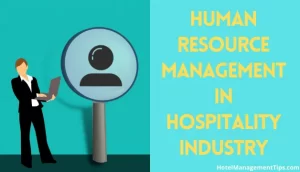What is Human Resource Management in Hospitality Industry?
Human Resource Management (HRM) is the management of people to achieve behavior and performance levels that will enhance an organization’s effectiveness. It is a management function that helps managers plan, recruit, select, train, develop, remunerate, and maintain members of an organization.
Hotel HR encourages individuals to set personal goals and rewards, guiding them to shape their behavior in accordance with the objectives of the organization that employs them. HRM was traditionally called Personnel Management, a term that was used in the restricted sense of hiring and managing employees.
The current trends place a greater emphasis on boosting the morale of employees and ways of retaining them by using more sophisticated psychological tests in selecting employees, training employees to do more than one job, and encouraging all the members of a workforce to accept responsibility.
Human Resource Management can be studied under the following two subheads:
- Human Resource Planning.
- Human Resource Development
Introduction to Human Resource Department in Hotel
Efficient, hard-working, and resourceful personnel are the backbone of any successful business. It is more so in the case of the service industry. Successful hotel operations are sustained by customer-oriented and hard-working employees who have adequate competencies.
The human resources department of a hotel is engaged in the anticipation, acquisition, selection, and development of the present and future employee needs of the hotel. It also includes the processes of job evaluation, recruitment, selection, and orientation.
The challenges faced by the human resources department in the hospitality industry are also discussed, as are the ways to boost employee retention and employee motivation.
Importance of Human Resource Management in Hospitality and Tourism Industry
Human resource management (HRM) is a management function that helps managers Plan, Recruit, Select, Train, Develop, Remunerate, and maintain members of an organization. HRM comprises human resource planning and development.
Human resource planning is a strategy for the acquisition, utilization, improvement, and preservation of the human resources of an organization.
Human resources is the process of helping people acquire competencies and skills so as to ensure their usefulness to the organization in terms of both present and future organizational conditions.
The human resources department of any organization carries out functions like job analysis, recruitment, selection, orientation, and training.
The department also faces many challenges, which include making employees cope with long working hours, finding qualified staff, etc. The means to retain and motivate employees.
1. Employee Retention
The following factors are important in order to retain employees:
Employees should know what is expected of them every day at work. Changing expectations keeps people on edge and creates unhealthy stress. They rob the employees of their confidence.
Effective Supervisor: People leave managers and supervisors more often than they leave companies or jobs. It is not enough that the supervisor is well-liked or is a nice person; he should be able to motivate and encourage his/her team members.
Employee Counseling: The managers should have a goal to restore employees to full productivity. The HR department or the head of the department can provide confidential short-term counseling to identify an employee’s problem.
Talent and Skill Utilization: A motivated employee wants to contribute to work areas outside of their specific job description. Many employees can contribute far more than they currently do.
Fairness and Equitable Treatment: If one employee is given more raises or higher incentives, other staff members might find it unfair and start looking for other opportunities.
Frequent Opportunities to Learn and Grow: A career-oriented, valued employee must experience growth opportunities within the organization.
Employees should feel rewarded, recognized, and appreciated. Frequently saying thank you goes a long way. Monetary rewards, incentives, bonuses, and gifts make the thank you even more appropriate. Salary raises, based on accomplishments and achievements, help motivate and retain staff.
2. Employee Motivation
Motivation is one of the most important factors that directly affect human behavior and performance. Motivation may be defined as the driving and guiding force that makes people perform a particular activity to the best of their abilities.
The word motivation is based on the root word motive, which is derived from the Latin word movere, meaning to move.
Employees can be motivated by the following methods:
1. Training: Training employees may convey to them that the organization takes necessary care of its employees. An employee who has received training has a higher chance of promotion and other benefits.
2. Cross-Training: Cross-training is training employees for roles other than their routine jobs. It helps the employees acquire new skills, which may lead to career growth.
What is the Role of HR in the hotel industry?
In an organizational context, HRM is a process that helps the employees of an organization in a continuous and planned way to do the following things,
- Acquire or sharpen the capabilities required to perform various functions associated with their present or expected future roles.
- Develop their general capabilities as individuals and teams, discover and exploit their inner potential for their own and organizational growth and development purposes.
- Develop an organizational culture in which supervisor-subordinate relationships, teamwork, and collaboration among subunits are strong and contribute to the professional well-being, motivation, and pride of employees.
HR Challenges or Issues in Hospitality Industry
These are the challenges of HRM in the hospitality industry:
1. The characteristics of work in hotels and catering—long, anti-social hours, low pay, instability, and low status—make it unattractive as a career choice. As a result, the sector continues to suffer from high staff turnover and difficulties in recruiting qualified staff.
2. The hotel staff works especially hard on those days when the rest of the world is enjoying vacations, such as Diwali, Christmas, New Year’s, and long weekends. The hotels are generally booked to capacity during such festival and holiday seasons, and the hotel staff is required to work overtime during these periods.
3. Long working hours increase stress on individuals and have potentially harmful effects on their psychological and physical health. Social effects might include an increase in family tension and stress in marital relations.
4. For the organization, it could lead to poor labor productivity both in terms of increased absenteeism and declining marginal productivity of labor when present at the workplace but working long hours.
5. One of the challenges in improving working conditions is ensuring that both employees and employers engage in the process so that improvements are consistent with the aspirations and wishes of both groups: higher margins and productivity for businesses, higher wages, and a better work-life balance for employees.
6. Having set about improving working conditions, the next challenge is to attract and retain the correct staff. To deal with this, some employers have focused on job satisfaction and designed systems to reward staff for their
performance. Key employee retention is critical to the long-term success of any business.
7. Retaining the best employees ensures customer satisfaction, product sales, effective succession planning, and deeply embedded organizational knowledge and learning. The HR personnel should analyze the results of the exit interviews, come up with remedial solutions, and initiate action.
Duties and Responsibilities of HR Manager in Hotel
Human Resource Development (HRD) is the process of helping people acquire competencies and skills so as to ensure their usefulness to the organization in terms of both present and future organizational conditions.
HRD also helps employees understand their own capabilities better so that they can best utilize them and fulfill their professional and personal expectations.
List of duties and responsibilities of a hotel HR manager:
1. Job Analysis
Job analysis is the process of collecting information about a particular job position. It may be defined as a process of studying and collecting information relating to the operations and responsibilities of a specific job. The process of job evaluation results in the generation of a large chunk of data related to a job position.
The collected data can be grouped into the following subcategories:
a) Job Description
The job description is a document that contains duties, responsibilities, and all the tasks that constitute a job position. It specifies the parameters within which a job is done.
It not only includes duties and responsibilities but also contains report relationships, working conditions, authority and control, coordination with other departments, status within the departmental hierarchy, equipment and materials to be used, and other information specific to the hotel.
b) Job Specification
A job specification is a document that contains information about the skills and qualities required for a position. It includes information such as personal qualities, skills, formal education, professional/technical qualifications, work experience, general knowledge, previous training, physical skills, equipment skills, and communication skills of a person.
2. Purpose of Job Analysis
Job analysis is useful for the overall activities of the HR department. The information generated during job analysis helps the department in the following activities,
a) Human Resource Planning
Human resource planning is the activity that assesses the present and future requirements of manpower for the organization. Job analysis helps the human resource manager decide on the skills needed in the organization to carry out present and future tasks.
b) Recruitment and Selection
The recruitment process for the employees begins after the organization assesses its present and future manpower requirements. Once a recruitment position has been identified, the job description and job specification of that position are drawn up, which define the scope of the job and the skills needed.
This way, managers are able to delegate job responsibilities more effectively, and HR managers have a better idea of the qualities that they should look for while selecting future employees.
c) Training and Development
The training and development activities may be tailored as per the requirements of the job. Job analysis data helps to decide the training needs and the procedure for training present and future employees.
d) Job Evaluation
Job evaluation involves the determination of the relative worth of each job for the purpose of establishing wages and pay packages. Job description and job specification are the foundations for the determination of the relative worth of a job.
e) Performance Appraisal
The assessment of the performance of employees is made on the basis of the job description. Performance appraisal is the basis for awarding promotions, effecting transfers, or ascertaining the training needs of employees.
3. Recruitment
The need for personnel in any organization is fulfilled by attracting the right set of people for existing and future job positions in the organization. The process of attracting people with desired qualifications and traits and motivating them to apply for suitable job positions is known as recruitment.
Recruitment can be defined as the process of finding and attracting capable applicants for employment. The process begins when new recruits are sought and ends when their applications are submitted.
Recruitment serves the following purposes:
- Recruitment attracts highly qualified and competent people.
- It provides a pool of potentially qualified candidates for various job positions at a minimum cost.
- It meets the organization’s legal and social obligations regarding the composition of its workforce.
- It identifies suitable candidates for various job positions.
4. Selection
Selection is the process of choosing the right candidate from the pool of applications received in the recruitment process. The selection is done strictly on the basis of the skills and competencies required for the job position. A candidate with the right qualifications, skills, and traits is selected for the job.
So selection may be defined as a process of differentiating between applicants in order to identify those with a greater likelihood of success in the job.
5. Orientation
Orientation may be defined as a planned introduction of new employees to their jobs, their co-workers, the management, and the organization. Orientation is also known as induction. It is designed to provide new employees with the information they need to work efficiently and effectively in the organization.
Orientation may be informal, where employees get introduced to co-workers while performing their job, or it may be formal and structured, which may extend from one week to several months.




